Bharat Mobility Global Expo 2025 Automakers And Ecosystem Partners Back India’s Growth Story
- By Nilesh Wadhwa
- March 06, 2025

All roads led to Delhi-NCR as automakers, component suppliers and allied ecosystem players showcased their mettle and contributed to the success of the world’s second-largest automotive show – Bharat Mobility Global Expo 2025.
The six-day megaevent beginning 17 January 2025, spread across three venues had focus on nine key aspects of mobility. This included The Auto Expo Motor Show 2025, India International Tyre Show 2025, India Cycle Show 2025, Bharat Battery Show, Steel Pavillion and Mobility Tech Pavillion at Bharat Mandapam, new Delhi. The Auto Components Show 2025 at Yashobhoomi, Dwarka, New Delhi; Bharat Construction Equipment Expo and Urban Mobility & Infrastructure Show at India Expo Centre & Mart, Greater Nodia, respectively. The Bharat Mobility Global Expo 2025 had plenty of insights and updates for everyone.
In its second year, the Bharat Mobility Show 2025 was on the theme of ‘Beyond Boundaries: Co-creating Future Automotive Value Chain’. The idea was to foster collaboration and innovation across the automotive and mobility sector. For long, the Indian automotive market has been seen as a global trend follower, but now with the focus on manufacturing, technology and software-era, the country is becoming a globally major driving force.
The event spread across 100,000 square metres is said to have attracted around 983,522 visitors in the course of six days. It also hosted over 800 exhibitors, more than 500 delegates and conducted 20-plus conference with over 2,500 delegates in the span of six days. Interestingly, exhibitors had a total of 239 launches across all the concurrent shows, which is amongst the highest-ever recorded in India or probably the world.
What’s interesting to note is that, unlike most automotive global shows, the focus on different mobility ecosystem meant that exhibitors and visitors alike could have much more fruitful interactions, discussions thus leading to significant business opportunities.
Prime Minister Narendra Modi, who inaugurated the Expo on 17 January 2025, had said, “The entire mobility industry, the whole government and the whole nation have come together for this expo. Driven by the aspirations of the people and energy of the youth, India’s automobile sector is witnessing an unprecedented transformation.”
One of the key industries that has been working exhaustively behind the scenes to support the future of mobility is the tyre segment, as their products are the only point of contact between a vehicle and the road. And with the focus on sustainability at the forefront, tyre makers and allied players are increasingly stepping up their game to support the future of mobility.
INTERNATIONAL TYRE SHOW 2025
The Indian tyre industry is pegged at more than USD 11 billion (2022-23) with exports of around USD 2.9 billion (2022-23). The country is home to more than 28 tyre makers operating 62 plants, showcasing the robust domestic demand and also the manufacturing prowess.
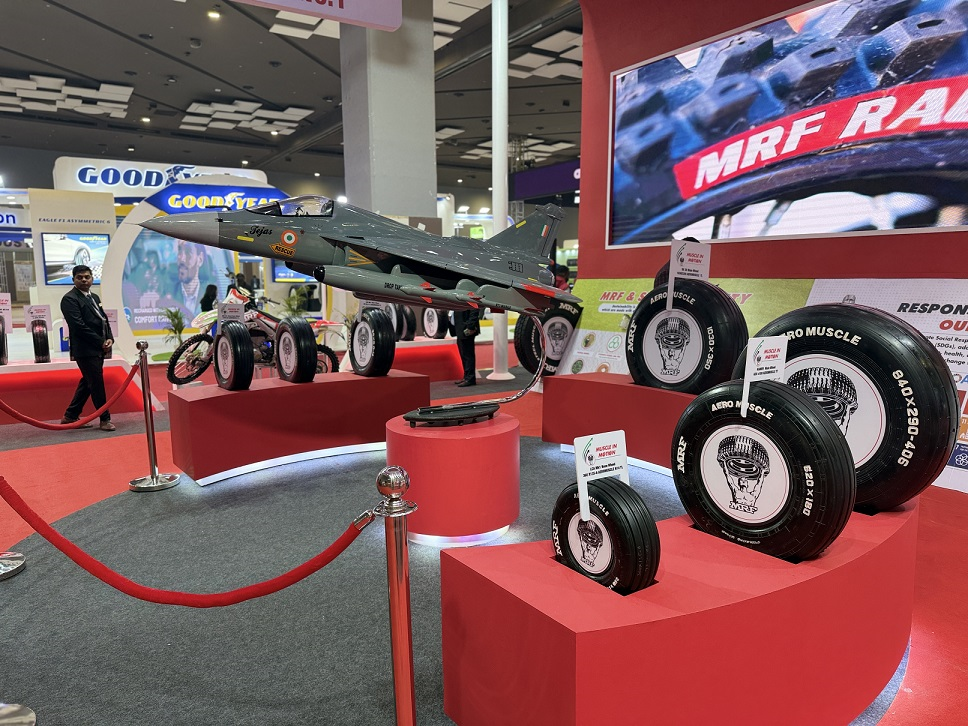
It was no surprise that a dedicated event was planned, where more than 30 companies across tyre makers and suppliers presented their solutions and services to showcase their latest offerings. Some of the companies present at the event include Amazon Web Services India, Apollo Tyres, Automotive Tyre Manufacturers’ Association, Bansal Wire Industries, Bridgestone India, Ceat, Eco Crumbs & Reclaim, Emerald Tyre Manufacturers, Epsilon Carbon, Fabhind, Fornnax Technology, GoGreen Enterprises, Goodyear, GRP, Himadri Speciality Chemical, INDAG Rubber, Indo Green Enviro, IRMI, JK Tyre & Industries, L&T Rubber Processing Machinerv, Madura Industrial Textiles, Michelin India, MRF, Neo Wheels, Parker Lord, Rajratan Global Wire, Ralson (India), Rubber Board, Rubber King Pvt Tyres, Sai Commodities, Sanathana Analytics and Recruitment Services, SRF, Tata Chemicals, Test Industry, Triton Valves and Tyreloop Intermesh.
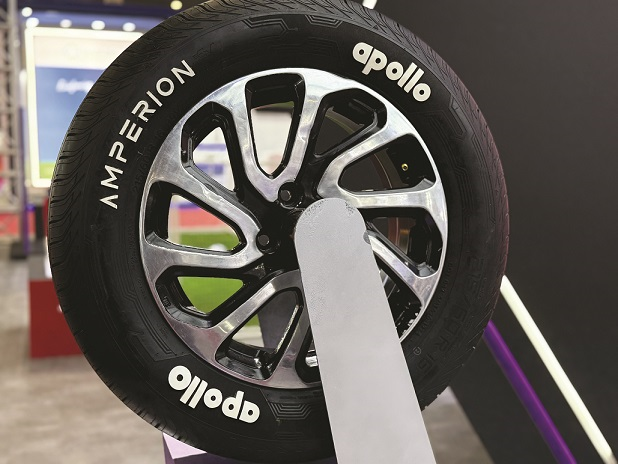 For tyre makers, besides displaying their popular products, a key focus was seen on showcasing their innovation to support the electrification trend in the country. In addition to using sustainable materials, electric vehicle (EV) tyres with foam-in tyre technology, which absorbs noise, was a key highlight at the event. On the other hand, the focus was on introduction of premium tyres; for instance, Apollo Tyres showcased the Vredestein tyre, which was being localised and supplied to a premium car maker in India.
For tyre makers, besides displaying their popular products, a key focus was seen on showcasing their innovation to support the electrification trend in the country. In addition to using sustainable materials, electric vehicle (EV) tyres with foam-in tyre technology, which absorbs noise, was a key highlight at the event. On the other hand, the focus was on introduction of premium tyres; for instance, Apollo Tyres showcased the Vredestein tyre, which was being localised and supplied to a premium car maker in India.
Bridgestone India on its part showcased the ENLITEN technology-based tyres, which the company claims offer the ‘ultimate customisation’ that provides enhanced ride comfort, lower noise, superior wear life and improved fuel efficiency. The tyres are designed for both IC-vehicles, EVs and can support a variety of formfactors such as SUVs, CUVs, sedans and hatchbacks. The ENLITEN technology is claimed to reduce raw material consumption and lower carbon emissions at both production and usage.
RPG Group-owned Ceat showcased its all-terrain tyres, the CrossDrive range, EnergyRide built for electric scooters, Winload Series – premium tyres for truck and tyres for the farm, mining and off-road segment. JK Tyre & Industries launched two new tubeless truck & bus tyres, JDL XM & JUM XM, in the truck category.
Ralson Tyres took the opportunity to announce its entry in the Indian commercial vehicle segment with the introduction of its globally proven technology. It was in 2023 that the company inaugurated its Indore facility to mark its foray in the commercial vehicle tyre segment. The 60,000 MTPA plant is almost running at full capacity and serves the North America, Europe, Latin America, Africa and the Middle East market.
The event provided an opportunity not only for tyre manufacturers to introduce new products but also for key suppliers and partners to showcase their latest technologies. Michelin displayed its wide range of tyres from Lunar tyres and concept tyres to tyres made of recycled materials and high-performance commercial tyres.
Indag Rubber, a leading supplier of pre-cured tread rubber (PTR) solutions, introduced Win Master, which it claims is a revolutionary PTR brand that enables one of the highest 100,000-km mileage on radial tyres. This high on sustainability solution, it believes, will reduce operational costs and provide exceptional value to fleet owners.
Epsilon Carbon, a leading supplier of carbon black, launched Terrablack, its new product line, which is said to support tyre makers drive towards sustainability.
The company shared that Terrablack used recovered Carbon Black (rCB) and Tyre Derived Oil (TDO), which offers high-performance, eco-friendly solutions to meet the needs of both the tyre and non-tyre industries. It is said to have been extensively tested for 24 months. The Terrablack portfolio includes Terrablack 3310, engineered for heavy-duty applications like tyre treads, which provides superior wear resistance and durability, whereas Terrablack 6615 was designed for flexibility and resilience, ideal for tyre sidewalls, hoses, belts and sealing systems.
The company also announced its plans to establish a fully integrated tyre recycling plant in Karnataka, which is expected to go live by FY2026. This facility will recycle 30,000 tonnes of tyres annually and generate 9,500 tonnes of recovered carbon black and 12,000 tonnes of tyre-derived oil.
AUTO SHOW 2025
One of the most prominent highlights of the Bharat Mobility Auto Show 2025 was the Auto Expo, where legacy and new-age automakers wanted to showcase not only their newest offerings but also their global range and their imagination of what the future vehicles would look like.
It is interesting to note that a total of 90 vehicles were launched at The Auto Expo Motor Show 2025. A vast majority of them being electric and in some cases flex fuel and other alternative powertrains.
In the passenger vehicle segment, Maruti Suzuki India, the country’s largest carmaker, formally marked its entry in the EV segment with the e Vitara – a pure electric SUV with a claimed range of up to 500 km. Hyundai Motor India too introduced the Creta Electric SUV, its first EV offering on its most popular product in the country. VinFast, the Vietnam-headquartered auto maker, showcased its global product offerings across passenger vehicle and two-wheeler segment, which are expected to be introduced soon in the country.
The luxury segment saw the introduction of the BMW X1 Long Wheelbase All Electric; Mercedes EQS Maybach SUV 680 ‘Night Series’ and Maybach GLS 600; JSW MG Motor India unveiled its premium affordable brand ‘MG Select’ and the first of its two offerings, the MG Cyberster and MG M9. Porsche India unveiled two groundbreaking EVs, the all-new Macan SUV and the updated Taycan sports saloon.
Tata Motors launched the new Tata Sierra, while Kia brought the new EV6. Skoda Auto India showcased its global portfolio along with concept vehicles. Other key highlights included the Suzuki Motor India’s Access electric scooter, Gixxer SF 250 Flex Fuel; Hero MotoCorp’s Xtreme 250R & Xpulse 210 motorcycles and Xoom 125, Xoom 160 scooters and Vida V2 e-scooter; Honda Motorcycle & Scooter India revealed the prices of the Activa e: and the QC1 e-scooters and Vayve Mobility showcased Eva, a solar panel integrated micro car for urban commute.
In the commercial vehicle space, Tata Motors, VE Commercial Vehicles, Eka Mobility, Ashok Leyland, Switch Mobility, Cummins India, SML Isuzu, JBM Auto, TI Clean Mobility, Omega Seiki Mobility and Olectra Greentech showcased their product offerings across ICE and EV offerings.
COMPONENTS SHOW 2025
Right over at the recently opened Yashobhoomi, the Auto Components Show 2025 was home to over 1,000 exhibitors showcasing their products and solutions for supporting the automakers in their quest for sustainability.
Spread across 70,000 square metres, it attracted almost 100,000 visitors with 60 new product launches, interactive forums and engaging activities. Component makers across tier-1, tier-2, tier-3 and ancillary industries took the opportunity to not only showcase products for IC-vehicles and EVs but also presented live demonstrations for manufacturing and shopfloor activities.
This state-of-the-art exhibit featured transformative solutions shaping the future of transportation, from contributors like Bosch, HCLTech, Tata Elxsi, KPIT, QuestGlobal, and Capgemini, alongside other startups and mobility service providers.
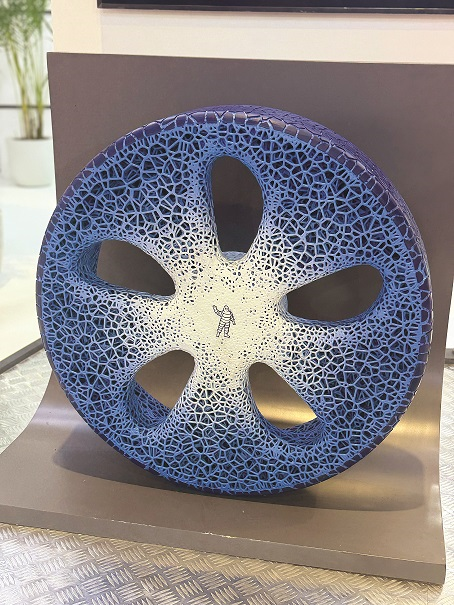 The component makers proved their mettle by showcasing not just made-in-India but also designed-in-India products. Some of the key exhibition included DGMS-compliant safety technologies by Novus Hi-Tech to revolutionary Paint Protection Films by ALP Group, advanced EV solutions by BorgWarner and ParaSafe’s Jacket and Jeans designed specifically for motorcyclists, delivery personnel and high-risk users, representing a transformative leap in personal safety and mobility.
The component makers proved their mettle by showcasing not just made-in-India but also designed-in-India products. Some of the key exhibition included DGMS-compliant safety technologies by Novus Hi-Tech to revolutionary Paint Protection Films by ALP Group, advanced EV solutions by BorgWarner and ParaSafe’s Jacket and Jeans designed specifically for motorcyclists, delivery personnel and high-risk users, representing a transformative leap in personal safety and mobility.
To conclude, the Bharat Mobility Global Expo 2025 offered a comprehensive glimpse into the future of mobility, from software-driven innovations to sustainable manufacturing practices. With its broad focus on passenger vehicles, commercial vehicles, tyres and components, the event underscored India’s emergence as a global leader in the automotive sector.
As India continues to champion sustainability, technology and localisation, Bharat Mobility Global Expo is slated to play a pivotal role in shaping the global automotive landscape.
Trelleborg Tires Retains Crown As Brazil's Best Agriculture Tyre
- By TT News
- December 07, 2025
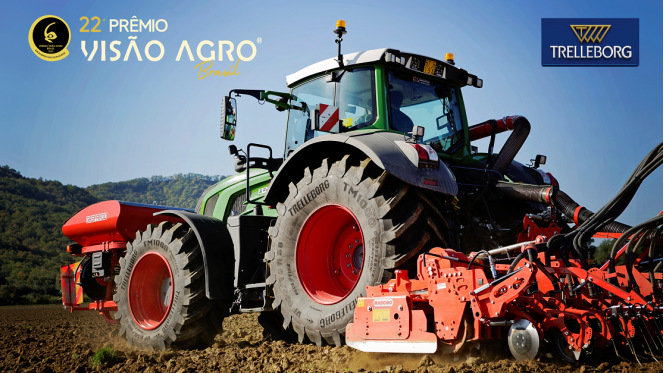
For the second consecutive year, Trelleborg Tires has earned the prestigious title of Best Agriculture Tyre at the 22nd Visão Agro Brazil Awards. This 2025 accolade, presented during a ceremony in Ribeirão Preto, highlights the company’s dedicated role in advancing Brazilian agribusiness through technological leadership and a commitment to sustainable practices. The award was received on behalf of the company by Fábio Metidieri, Agri Sales Director for Yokohama TWS Brasil.
Central to this achievement is Trelleborg’s ongoing innovation, particularly the expansion of its ProgressiveTraction technology within the TM tyre series. This engineering, featured in models from the row-crop TM600 to the high-horsepower TM1000, utilises a dual-edge lug design. The tread operates progressively on the soil to enhance traction, promote self-cleaning and minimise vibration. The resulting benefits include improved operational efficiency, increased tyre durability and superior soil protection, directly supporting farmers’ goals for greater productivity and environmental stewardship.
The company’s deep roots in Brazil, supported by a specialised local team, rigorous field testing and strong manufacturer partnerships, ensure its solutions are finely tuned to regional demands. This local infrastructure allows for responsive technical service and keeps product development closely connected to the practical challenges faced by the agricultural sector. The Visão Agro Brazil Awards, judged by a panel of industry executives and researchers, serve as a recognised benchmark for innovation and performance, making this recognition a significant testament to Trelleborg Tires’ impact on the country’s farming landscape.
Metidieri said, “Receiving this award at such a prestigious event once again reinforces our commitment to Brazilian agriculture. Our goal is to keep advancing in technology and field performance, ensuring that every Trelleborg tyre delivers real value – helping farmers operate more efficiently, sustainably and profitably. This award reflects the trust placed in our team and our products by professionals throughout the sector. It strengthens our commitment to delivering technologies that address local challenges and help shape the future of Brazilian farming.”
Premium Makeover
- By Sharad Matade
- December 05, 2025
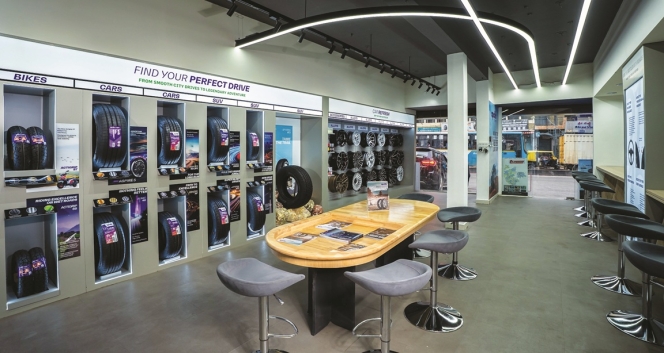
India’s tyre retail industry is undergoing a dramatic makeover, moving far beyond the cluttered workshops and transactional buying of the past. Fuelled by rising demand for premium vehicles, digital-first customers and stronger export momentum, tyre makers are transforming retail spaces into sleek, immersive experience centres. What was once a routine utility purchase is rapidly evolving into a premium, advisory-led mobility experience designed for a new generation of motorists.
India’s tyre retail scene is shifting gears, leaving behind the era of crowded workshops and impersonal counters. In their place, manufacturers are rolling out sleek, thoughtfully designed, tech-powered spaces that echo the luxury of high-end car showrooms. What started as a few bold pilots in big cities has quickly become the go-to playbook for tyre brands eager to win over a new generation of savvy, comfort-loving, digital-first customers.
From urban to rural areas, this transformation reveals a profound change in how Indians approach mobility. Today’s motorists – especially those behind the wheel of SUVs, luxury sedans and electric cars – want more than just a tyre swap. They crave expert advice, a polished atmosphere and a shopping experience that reflects the elegance of their vehicles. Once a utilitarian afterthought, tyre retail is now emerging as a coveted part of the automotive journey.
Strong OEMs and replacement demand in both domestic and export markets underpin the transition.
In FY 24-25, tyre exports from India surged by nine percent year-on-year to INR 251 billion, according to data released by the Ministry of Commerce. With an estimated annual turnover of INR 1 trillion and exports exceeding INR 250 billion, the Indian tyre industry stands out as one of the few manufacturing sectors in the country with a high export-to-turnover ratio.
Though tyre exports have hit a speed bump due to higher US tariffs on select categories of Indian tyres compared to those of competing nations, the long-term prospects for the Indian tyre industry remain strong. According to a joint report by ATMA and PwC India titled ‘Viksit Bharat 2047: Vision and Roadmap for the Indian Tyre Industry’, India’s tyre production volumes are projected to grow nearly fourfold by 2047, while industry revenues are expected to expand almost 12 times to about INR 13 trillion.
Against this backdrop, tyre makers are modernising aggressively to retain customers and build a more profound emotional affinity. The broad shift is visible in how retailers are reinventing their spaces. Lounges with crafted lighting, upholstered seating, minimalist décor and large digital walls are replacing traditional steel racks and dusty counters. Informational murals and heritage display trace decades of tyre innovation, strengthening brand storytelling. Stores increasingly feature curated experience zones where customers can explore tyre technologies, EV-compatible profiles, eco-friendly materials and performance characteristics through visual displays and interactive tools.
A clear sign of this trend is the rise of personalised, advisory-led engagement, replacing the old dependence on technicians. Retailers now profile driving habits, terrain usage, daily distance and vehicle type to recommend tyres customised to each consumer’s pattern. This service-led model is shifting the customer’s mindset from price-first decision-making to long-term value evaluation.
The new premium outlets are designed to deliver a lifestyle-driven, hospitality-grade experience rather than a traditional tyre shop visit. Customers receive personalised mobility recommendations tailored to their vehicle, driving style and needs, supported by smart service innovations like intelligent product selection, quick-fit services and digital scheduling. The space also acts as a community hub for driving enthusiasts, creating a connected ecosystem around the brand. With lounge-style comfort, immersive storytelling and specialised tyre and service packages for luxury and performance vehicles, the outlet blends convenience, premium care and brand-centric offerings into an elevated customer experience.
“Customer experience at the point of sale is another branding exercise poised to change buyer characteristics. Multi-brand outlets often commoditise the tyre-buying experience. That’s why companies are launching exclusive brand outlets with curated customer experiences. Over the next decade, new delivery models will emerge,” said Kavan Mukhtyar, Partner and Leader – Automotive, PwC India.
Apollo Tyres articulates this change as a move towards lifestyle-led retailing. Its new super-premium outlets have been built not as showrooms but as emotionally resonant spaces.
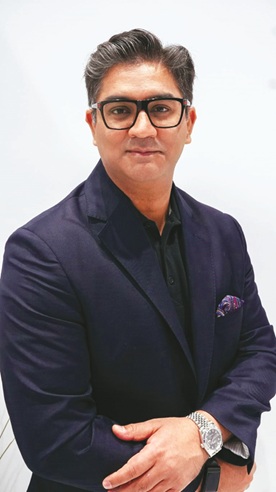
Udyan Ghai, Group Head of Marketing at Apollo Tyres, explained that the company’s new retail architecture is anchored in long-term strategic priorities: “Our move to a lifestyle-led, immersive tyre retail format is driven by our own desire for premiumisation and category leadership. We are looking at elevating tyre retail in India by setting new benchmarks and shifting from commodity selling to a premium, lifestyle-driven experience.”
He said the brand aims to ‘emotionally engage with customers, offer tailored solutions, build a community of driving enthusiasts and tap into premium segments – all while delivering a differentiated, modern retail experience’.
Ghai believes retail ambience plays a decisive role in influencing perception. “A relaxed and well-designed lounge signals comfort, trust and premium value,” he said, adding that such environments elevate tyres from a mundane requirement to a core element of vehicle care and identity.
Digital transparency, he believes, is the second pillar of modern tyre retail. “Digital systems ensure transparency and help demystify tyre selection – tread patterns, speed ratings, durability and fitment. Consumers feel less dependent on a technician’s word and more in control, which boosts their confidence and perceived fairness,” Ghai said.
Customers today are inundated with choices, and digital systems, he said, turn tyre buying into an ‘informed, personalised decision’, comparable to selecting a smartphone, a pair of performance shoes or even a detailed insurance plan. According to Ghai, this new retail model is ‘a strategic investment in the future of mobility retail’, designed to be scalable and to support community-building events, workshops and enthusiast interactions. As India moves towards EVs and connected cars, he said these premium outlets will provide EV-focused tyre expertise, interactive digital tools and personalised recommendations that appeal to younger, digitally savvy motorists.
CEAT shares a similar philosophy. Its national retail revamp focuses heavily on digital immersion, consistent messaging and design-led layouts. Lakshminarayanan B, the company’s Chief Marketing Officer, said the modernised CEAT Shoppes are fundamentally reshaping the category.
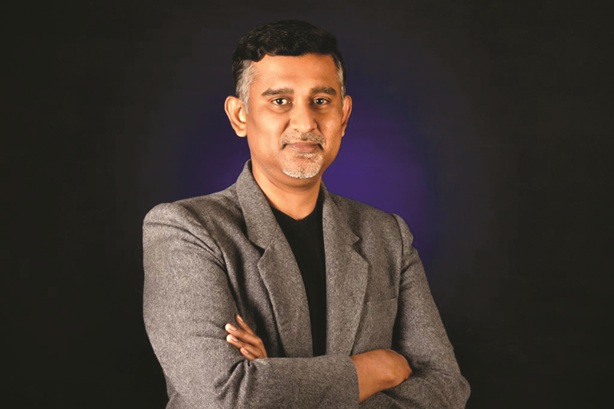
“The modern layouts and digital integration in CEAT Shoppes are revolutionising the tyre-buying experience, making it more experiential and customer-centric,” he said, adding that these updated outlets elevate the experience, build trust through uniform communication and drive decisions by reducing ambiguity around features and value.
Lakshminarayanan highlighted CEAT’s attempt to harmonise customer experience across demographics: “The approach in urban markets through premium stores, product offerings and services is to create access and aspiration for premium customers. The same is replicated in upcountry markets also.”
The CEAT Executive said the company is building for a future where personalisation will be the defining characteristic of tyre retail. “CEAT is focused to drive the future of tyre retail through end-to-end personalisation,” he said.
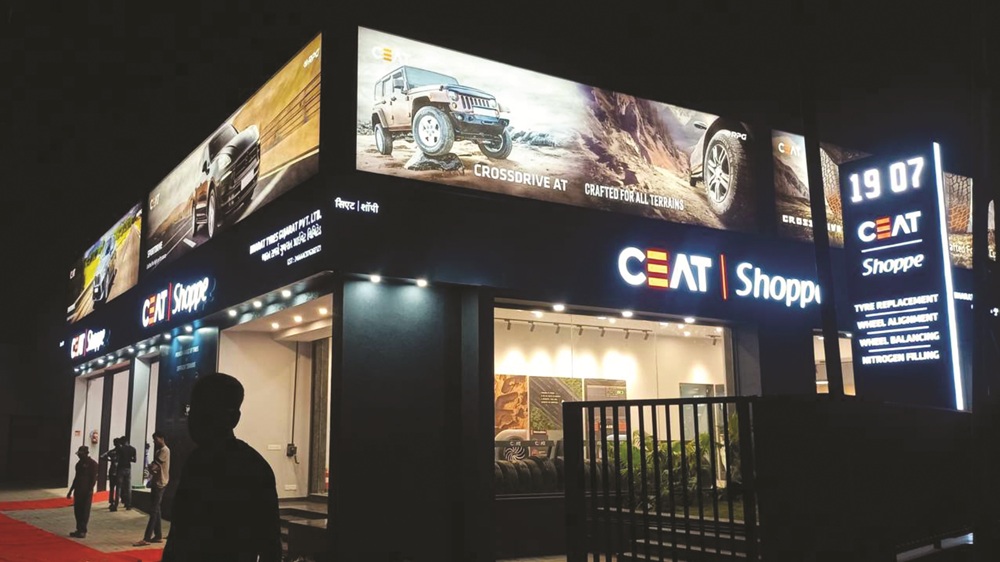
As experiential retail takes hold, service portfolios inside tyre stores are expanding faster than ever. Advanced wheel balancing, laser-driven alignment systems, nitrogen inflation, premium alloy wheel installations, EV-oriented tyre consultations, digital appointment scheduling and real-time tyre-health diagnostics are now standard. Many outlets also provide car detailing, interior cleaning, ceramic coating, PPF application, brake checks, battery inspections and multi-point vehicle health reports, making them full-fledged mobility centres.
Global players have pushed the envelope even further. Michelin’s 25,000-square-foot Experience Store in Nashik features a heritage wall and innovation displays showcasing electric mobility, materials science and environmental responsibility. It houses precision wheel-alignment bays, detailing studios, and accessory galleries. “We are proud to unveil Michelin’s first Experience Centre in India. The sole purpose of this store is to go beyond traditional tyre retail and provide customers with an immersive experience of the brand,” said Shantanu Deshpande, Managing Director of Michelin India.
Continental Tyres is also strengthening India’s premium retail ecosystem through its CPD outlets, which include ambient lounges, diagnostic equipment, premium alloy wheels and digitally enabled guidance. “With our new CPD store in Indore, we bring Continental’s promise of safety, innovation and comfort closer to Madhya Pradesh’s clients,” said Samir Gupta, Managing Director of Continental Tyres India. He added that the brand’s ‘In the Market, For the Market’ approach is central to its retail expansion strategy.
Even in rural markets, tyre retail is becoming more formalised, structured and service-oriented. JK Tyre’s ‘Steel Wheels’ format is targeted at towns with populations under 100,000 and offers standardised layouts, value-added services, best-in-market pricing and instant claim facilities. “Our Rural expansion programme will help us reach the interiors of the real Bharat that is economically vibrant but often underserved. We are not just building retail points; we are also enabling entrepreneurship and access,” said Managing Director Anshuman Singhania.
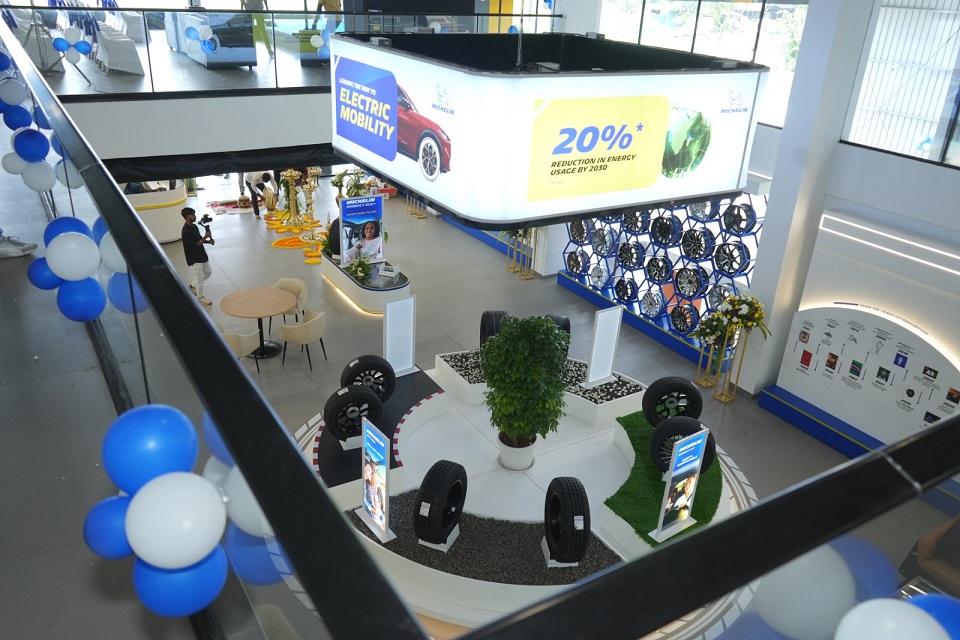 Together, these developments mark a decisive shift in how tyre brands engage customers. Tyre stores are increasingly functioning as lifestyle environments, designed for comfort, informed decision-making, personalisation, transparency and community. The industry is moving away from a product-first mindset to a customer-experience-led philosophy.
Together, these developments mark a decisive shift in how tyre brands engage customers. Tyre stores are increasingly functioning as lifestyle environments, designed for comfort, informed decision-making, personalisation, transparency and community. The industry is moving away from a product-first mindset to a customer-experience-led philosophy.
As premium cars, SUVs and EVs become mainstream, and as younger motorists prioritise digital empowerment and ambience, tyre retailers are aligning with these new expectations. India’s tyre makers are building a retail landscape where experiential engagement, technology integration, service breadth and emotional connection define long-term brand success.
For an industry long anchored in grease, metal and functionality, the transformation is profound. Tyre retail in India is no longer just about fitment; it is becoming a premium mobility experience, curated for a generation that demands clarity, comfort and an elevated relationship with every aspect of vehicle ownership.
Kumho Tire To Build First European Plant In Poland With $587mln Investment
- By TT News
- December 05, 2025
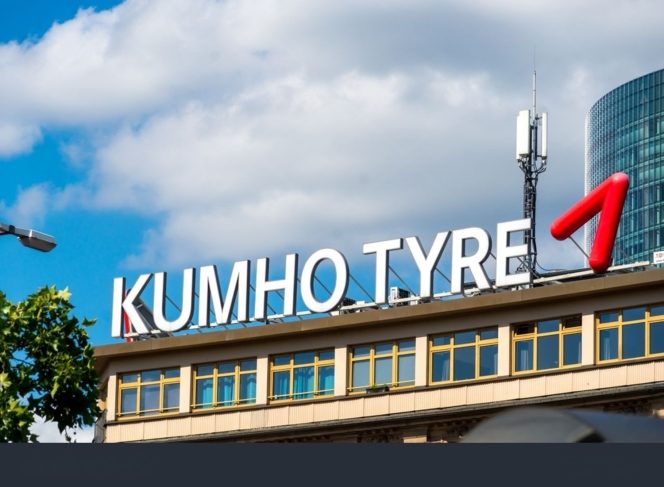
Kumho Tire will establish its first European manufacturing plant in Poland’s Opole region as the South Korean company seeks to expand its position in one of the world’s largest tyre markets.
The group said the factory is scheduled to begin initial operations in August 2028, subject to investment approval and licensing. Kumho plans to produce 6m units annually in the first phase and expand capacity in line with demand. Total planned investment is USD 587 million.
Kumho has spent recent years evaluating multiple European locations, including Poland, based on logistics, labour availability, infrastructure, market access and investment incentives. The company said Opole was selected as the optimal site owing to supply-chain stability within the EU and the region’s supportive operating conditions.
Europe accounts for about a quarter of global tyre consumption and is home to several major automotive manufacturers. The region represented roughly 26.6 per cent of Kumho’s sales last year. The company has previously relied on exports to serve European customers, which it said limited its competitiveness in the market.
The new plant is intended to strengthen Kumho’s ability to supply high-value-added products, including high-performance and larger-diameter tyres, to European vehicle makers.
Kumho currently operates eight production sites across South Korea, China, the US and Vietnam, with combined annual output of 65 millionunits. The Polish plant will complete what the company describes as a production network spanning Asia, Europe and North America.
Jung Il-taek, Kumho Tire’s Chief Executive, said: “The European market occupies a very important strategic position in the global tire industry,” adding that “Kumho Tire will go beyond simple exports and dramatically enhance premium brand value by strengthening quality and service competitiveness through local European production and supply.”
Tyre Stewardship Australia Appoints David Fraser As Chair As David Spear Steps Down
- By TT News
- December 04, 2025
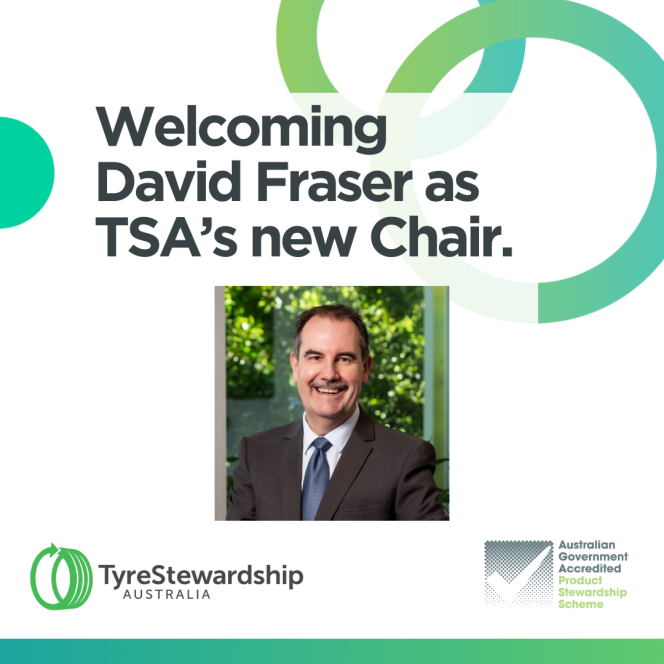
Tyre Stewardship Australia has appointed David Fraser as its new chair, succeeding David Spear after nine years in the role during a period of regulatory and industry change in the country’s tyre-recycling sector.
Spear’s departure closes what the organisation described as a challenging yet incredibly important chapter for its efforts to advance circular outcomes for Australia’s end-of-life tyres. TSA, an industry body backed by government and sector participants, oversees the national stewardship scheme and promotes recycling and re-use pathways for waste tyres, an area facing increasing scrutiny under Australia’s environmental and product-stewardship policies.
In a statement, TSA said it “thank[s] him for his unwavering support and dedication to driving circular outcomes for Australia’s end-of-life tyres”.
Fraser, a TSA director since 2023, brings experience in governance and compliance. He joins at a time when Australian states are tightening environmental standards and seeking to reduce landfill through higher recycling targets. TSA said Fraser has “deep understanding of our strategy, our challenges and the opportunities ahead”.
The organisation added: “We look forward to his leadership as TSA enters its next chapter.”
TSA also expressed appreciation to Spear “for your contribution and support of our mission”, and welcomed Fraser, saying it is “excited and ready for what lies ahead”.


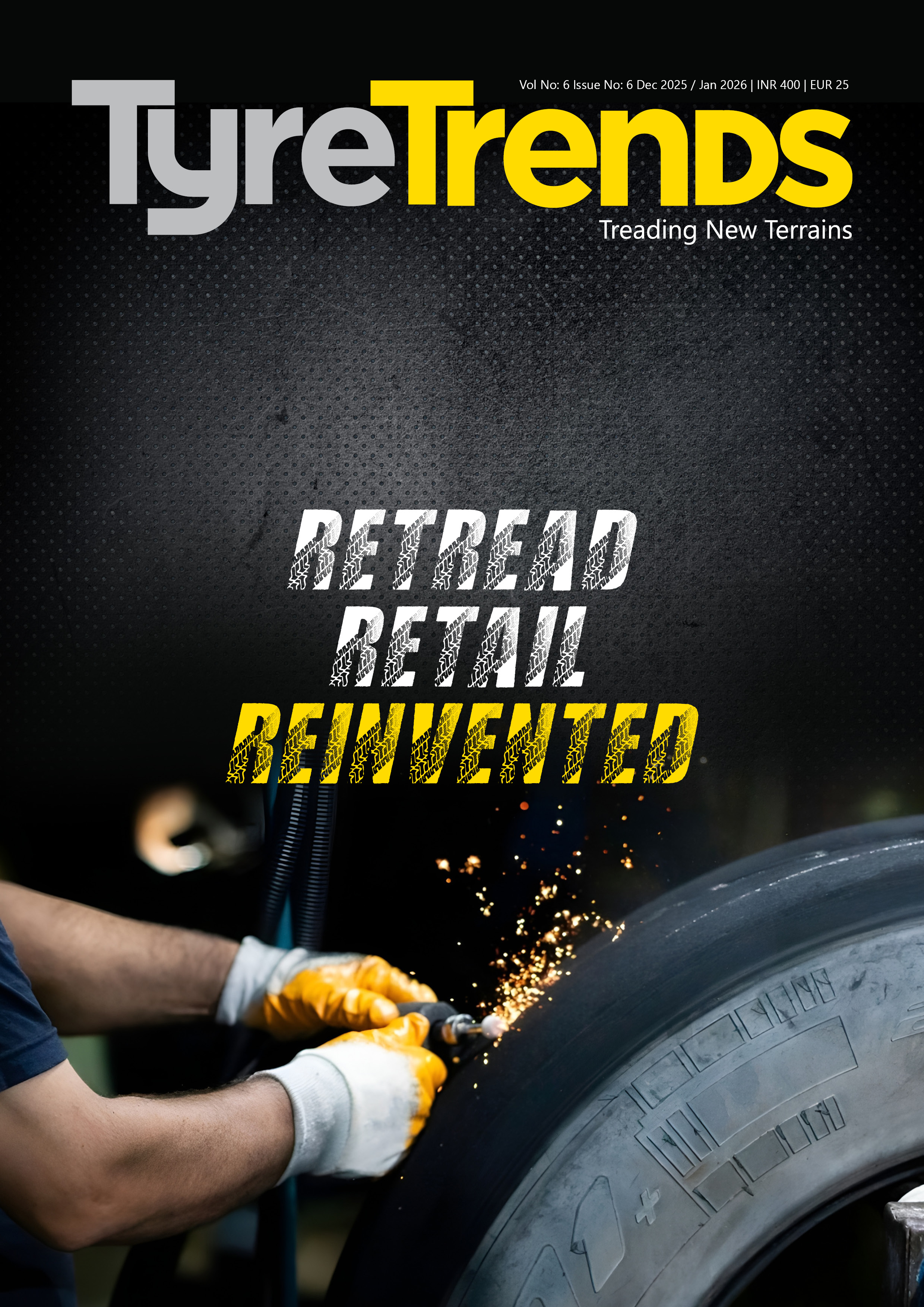

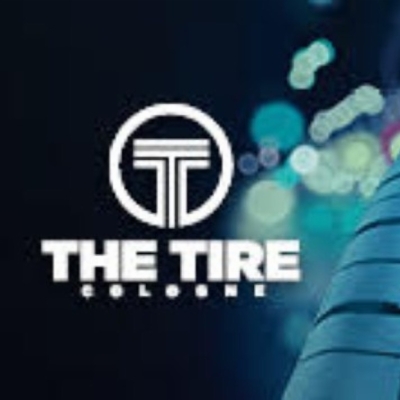


Comments (0)
ADD COMMENT